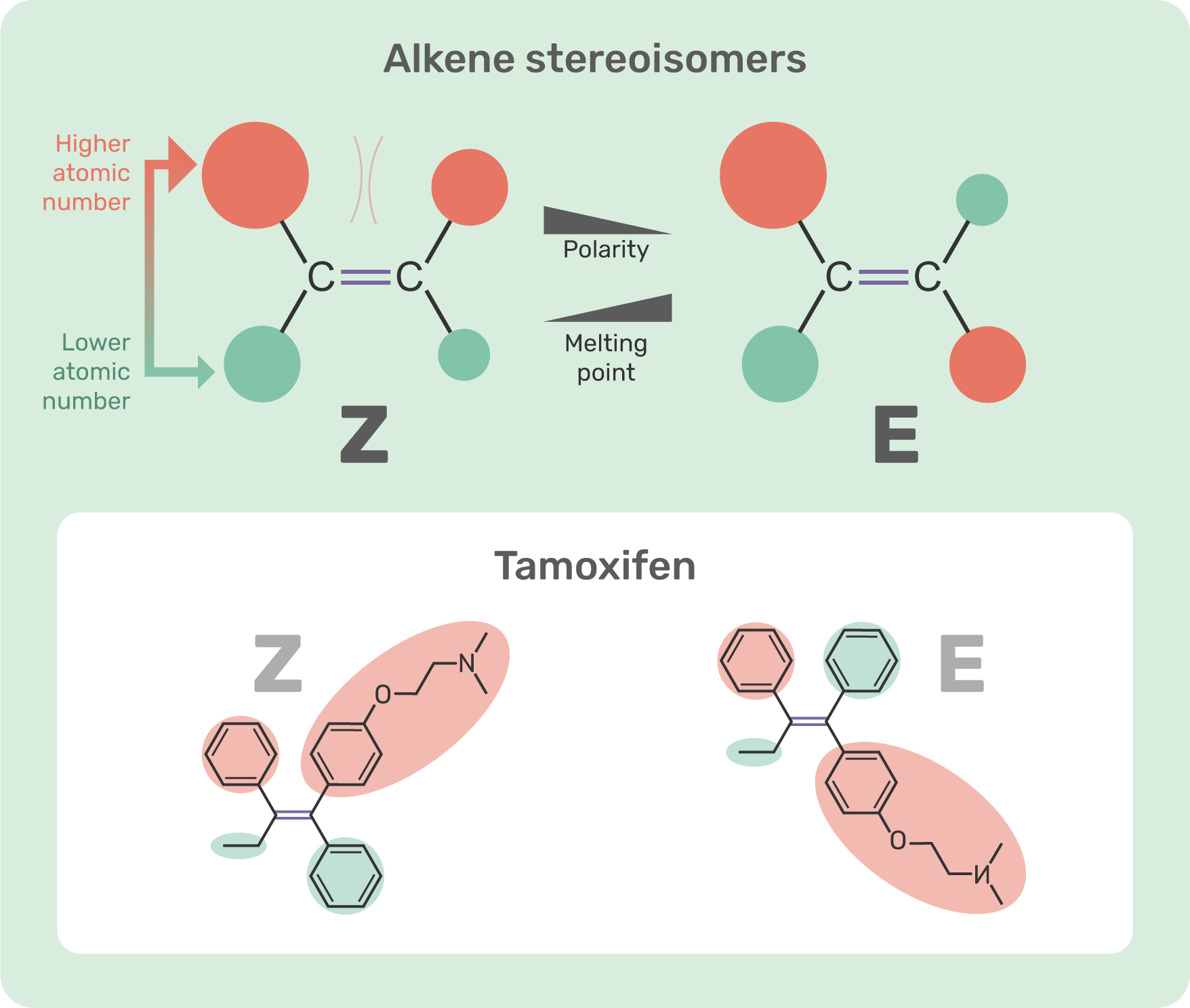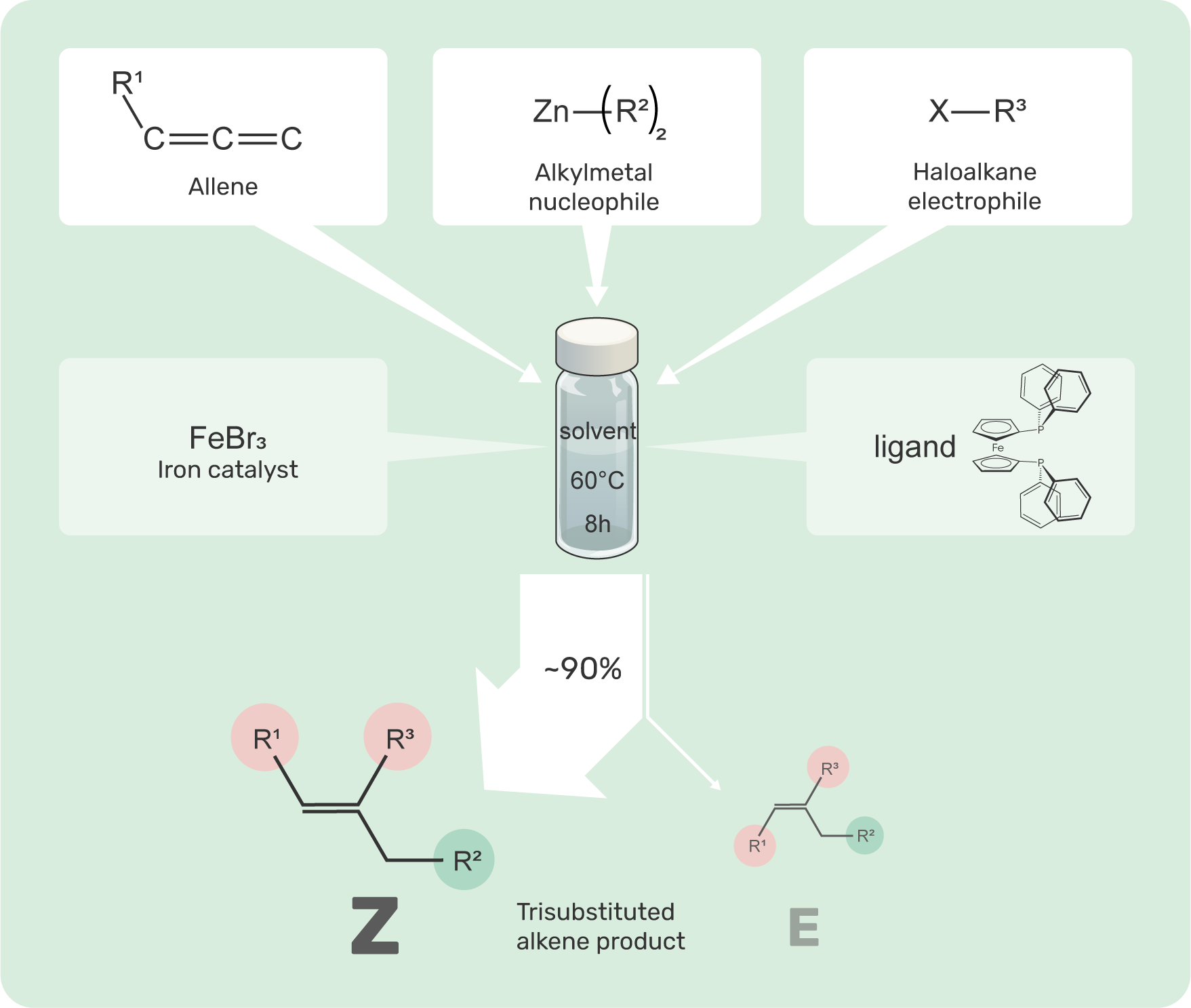Stereochemistry, or the spatial arrangement of atoms within a molecule, greatly influences the function of many chemicals and therapeutics used today. This is true for alkenes, which are fundamental hydrocarbons that contain carbon-carbon double bonds (C=C), and which are integral to many applications, from the manufacturing of plastics to therapeutics.

Z-isomers have higher priority groups on the same side of the double bond, while E-isomers have them on opposite sides. This difference in arrangement affects properties like polarity and melting points, and is particularly important in molecules like Tamoxifen, where Z and E isomers can exhibit distinct biological activities.
In Z-alkenes, the functional groups are located on the same side of the carbon-carbon double bond (C=C), while in the E-isomer, the same groups are positioned on opposite sides of the C=C. Often, Z-alkenes are desired due to their higher polarity and lower melting points compared to E-alkenes, making them versatile precursors or intermediates in the manufacture of other valuable molecules.
Tamoxifen, for example, is a therapeutic alkene used in the treatment of breast cancer, and which exhibits different functions depending on the stereoisomer produced. While both isomers bind the target estrogen receptor, the E-isomer activates the receptor, whereas the Z-isomer inhibits it. In dietary supplements, beta-carotene, a precursor to vitamin A, naturally exists in both Z and E forms, with the Z-isomer being more bioavailable and better absorbed in the body. Another example, fusidic acid, a common antibiotic for treating bacterial skin infections, relies on the Z-alkene configuration to inhibit bacterial protein synthesis, giving it its anti-bacterial properties.
Despite the high demand for Z-alkenes, current production methods remain expensive and environmentally unfriendly. Carbonyl olefination, for example, produces triphenylphosphine oxide as a byproduct which is challenging to remove. Alkyne functionalisation on the other hand relies on expensive palladium catalysts, while cross-metathesis uses precious metal catalysts like ruthenium.
While alternative metal catalysts are available, it is often challenging to recover and recycle them, especially in large-scale production processes. As a result, their use may lead to contamination of the product, and pose environmental risks, limiting the sustainability and scalability of Z-alkene production.
‘Greening’ chemical manufacturing
Now, a research team led by Associate Professor Koh Ming Joo from NUS Chemistry, has devised a method for the sustainable and efficient production of Z-alkenes. Their strategy incorporates allenes as starting materials, an iron catalyst, and a straightforward dialkylation reaction, where two alkyl groups are precisely installed onto the allenes. Allenes are hydrocarbons characterised by two adjacent carbon-carbon double bonds (C=C=C).

This method uses allene, FeBr3 as an iron catalyst, an alkylmetal nucleophile, a haloalkane electrophile, and the ligand S,S-BDPP to selectively produce trisubstituted alkenes. The reaction, performed at 60°C for 8 hours, yields about 91% Z-alkene and 9% E-alkene, demonstrating high efficiency and selectivity for the Z-isomer.
The research, which was described in
Nature Synthesis, was shown to produce trisubstituted
Z-alkenes which are important intermediates in applications such as therapeutics.
The highlight of the method is the use of an iron-based catalyst. Traditionally, iron has posed challenges in catalysis due to its ability to adopt multiple oxidation and spin states, which complicates the control of reactivity and selectivity.
According to Assoc Prof Koh, the work represents a significant breakthrough in ‘green chemistry’ as it not only accelerates the production of Z-alkenes and generates less waste, but its abundance as a less toxic and inexpensive transition metal makes their production more sustainable and cost-effective.
Using iron catalysts enhances efficiency, lowers costs, and aligns with environmentally friendly practices in organic synthesis, making it a superior choice for Z-alkene production. In an ideal scenario, we hope to replace all transition metal catalysts in the industry with inexpensive base metals like iron.
As a proof of concept, the team applied their approach to the synthesis of a glucosylceramide synthase (GCS) inhibitor containing a trisubstituted Z-alkene. Inhibiting the GCS enzyme can help reduce the accumulation of glycosphingolipids, which is associated with diseases such as Gaucher disease, cancer, and certain neurodegenerative disorders.
“Previous methods could yield Z-alkenes with only about 10% efficiency, in addition, the ratio of Z-alkenes to E-alkenes is nearly equal, resulting in poor selectivity, necessitating additional separation steps” he elaborated.
In contrast, the described method achieves a higher yield and selectivity, producing up to 91% of Z-alkene with only 9% E-alkenes.
The method successfully transformed various allenes, including those with functional groups like amines, halogens, and esters, into the desired products with good yields and high selectivity. It also proved effective in producing even more complex structures, such as tetrasubstituted alkenes.
This research was conducted in collaboration with Dr Xinglong Zhang from The Chinese University of Hong Kong. Computational studies from Dr Zhang provided insights into the reaction mechanisms, showing that π-π interactions between the groups on the allene and the ligand on the catalyst enhanced the reaction's efficiency by lowering the activation energy barrier.
Overall, this approach advances the synthesis of trisubstituted Z-alkenes and contributes to the field of sustainable iron catalysis.
"We foresee the widespread adoption of our iron-catalysed method as a practical and eco-friendly tool for creating valuable alkenes, which can support applications like drug discovery," Assoc Prof Koh added.
Moving forward, the team plans to apply similar approaches to the production of industry-relevant chemicals from other common raw materials.
References
Tan, T. D., Tee, K. Z., Luo, X., Qian, P. C., Zhang, X., & Koh, M. J. (2024). Kinetically controlled Z-alkene synthesis using iron-catalysed allene dialkylation. Nature Synthesis, 1-8.
